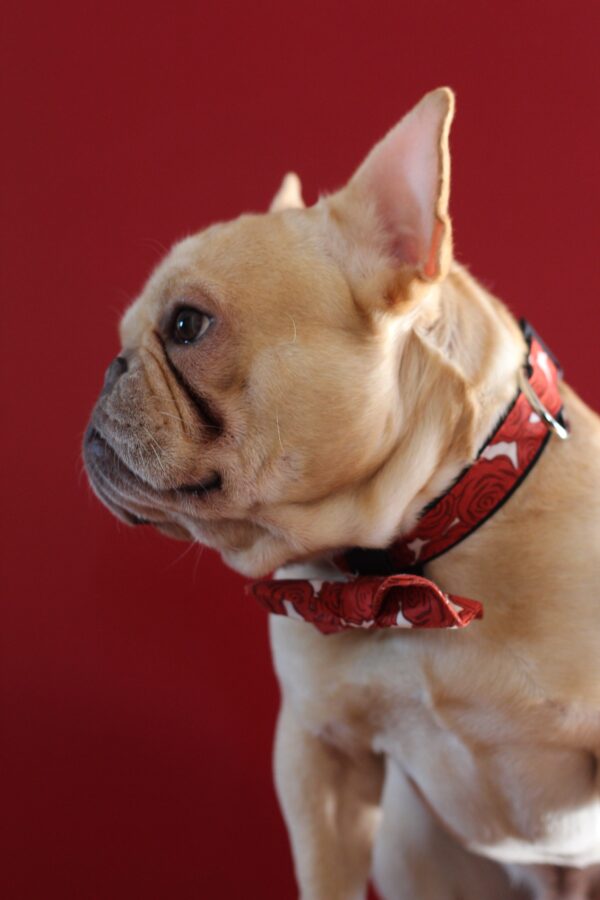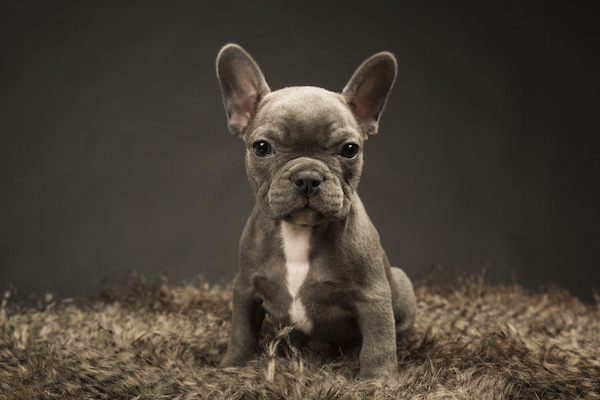I’m seeing an alarming trend in purebred dog breeding that disturbs me: Rare colors within a breed have become trendy. This fad isn’t new, but it is gaining traction and will be the downfall of purebred dogs, through the ignorance of breeders and owners alike.
As a retired breeder of French Bulldogs, I know they have many acceptable colors, but there are some that registering organizations do not allow. Not because they’re new, or from a hidden gene that suddenly emerged, but because they have been proven to harm the breed in some way. The same holds true with other breeds as well.

Cooper is a cream Frenchie, a standard color within the breed. (Photo by Alicia Kerns)
Frenchies who are all white or all black with no trace of brindle carry the deaf gene, and can produce blue-eyed dogs with eye problems. Liver or chocolate colors, as seen commonly (and safely) in Labradors, can produce yellow-eyed Frenchies with early blindness or juvenile cataracts. These are health issues that no pet parent wants to deal with, and ones that should never be imposed on an animal because a breeder wants to make money on a “rare color” or a person wants an unusual-looking pup. A good breeder will never risk a dog’s health, and a good owner has the responsibility of researching the breed they are getting.

Louie, a cream Frenchie, advocates for No Fad Colors. (Photo by Karen Dibert)
Other colors considered rare in French Bulldogs are the black and tan (like a Doberman), and the all black with no trace of brindle. These colors are so dominant that when used for breeding, will eliminate all other colors in the bloodline. It would be sad, indeed, to lose healthy fawns, brindles, creams, and pieds because a handful of unethical and uneducated people wanted blacks as well as black and tans.
The blue color is the biggest trend of all for Frenchies. They’re being bred and sold so quickly that there are waiting lists for the puppies. Blues (colored like a Weimaraner) have been more of an issue with the breed than any other fad color. This color tends to produce yellow- or green-eyed dogs, which as noted above can lead to blindness.

Blue French Bulldog by Shutterstock.
In addition, the color carries a genetic disorder that causes dry, scaly skin and hair loss. While this won’t be evident in a puppy, as the dog gets older problems will develop. Healthy dogs live longer, and cause less stress and worry for their pet parents. Setting yourself up for a lifetime of heartache, at your beloved pup’s expense, isn’t worth a designer color or a trending fad.
Please do your research before buying a dog of a particular breed. Sacrificing your pet’s future health, or contributing to your favorite breed’s eventual health decline, is not worth the bragging rights of having a rare dog. These are living creatures who suffer from our stupidity — not a handbag we’ll toss aside when it gets worn. Be a responsible owner, and enjoy your dog’s long healthy years as a result.
About the author: Karen Dibert is a wife, mom, and dog lover living in the Laurel Highlands of Pennsylvania. She has five kids, three French Bulldogs, and a flock of useless chickens. Karen authors a pet column for her local newspaper, advocates for her son with Down syndrome, manages Louie the French Dog’s Instagram accounts, compulsively photographs everything, and lives in the sewing room, filling orders for her Etsy shops, The French Dog, The French Dog Home, and Collar The Dog. A snapshot of her life can be seen on Facebook.
The post Why You Don’t Want Purebred Dogs in Rare Colors appeared first on Dogster.
No comments:
Post a Comment